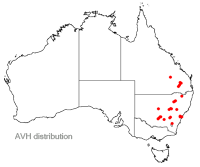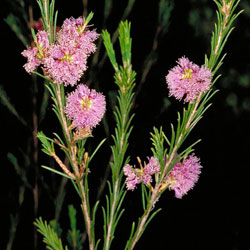Melaleuca diosmatifolia
Rosy Paperbark
Melaleuca diosmatifolia Dum. Cours.
Melaleuca diosmatifolia , commonly referred to as the Rosy Paperbark, occurs in the family Myrtaceae. Within Australia and Tasmania Melaleuca comprises the second largest genus after Eucalyptus with about 230 species of which 220 are endemic .
M. diosmatifolia may still be referred to by its synonym M. erubescens. However, this is an illegitimate botanical name (APNI). It should also not be confused with M.diosmifolia which is a completely different unrelated species . Lastly, M. diosmatifolia is not a true paperbark as stated by its common name.
 M. diosmatifolia is native to the Australian flora. It thrives along watercourses such as swamps or river flats subjected to inundation or open forest, woodlands with sandy soils that can cover a wide climatic distributional range that varies from sunny and open positions to light and shady conditions including moderate frost environment. Thus, the distributional range covers the western slopes and ranges of New South Wales, the Blue Mountains and coastal areas of the Sydney region and the woodland and open forest of Queensland including Darlings Downs. It is not considered to be at any form of risk in the wild.
M. diosmatifolia is native to the Australian flora. It thrives along watercourses such as swamps or river flats subjected to inundation or open forest, woodlands with sandy soils that can cover a wide climatic distributional range that varies from sunny and open positions to light and shady conditions including moderate frost environment. Thus, the distributional range covers the western slopes and ranges of New South Wales, the Blue Mountains and coastal areas of the Sydney region and the woodland and open forest of Queensland including Darlings Downs. It is not considered to be at any form of risk in the wild.
M. diosmatifolia grows as an erect open shrub that can attain heights up to 3m high and 2m wide. Its flower are pale to deep mauve that sprout on short lateral branches in cylindrical spikes that grow up to 3cm long and up to 2cm in diameter. Its fruit are barrel shaped and about 4mm wide; seeds are fairly small and can remain on the plant indefinitely. Leaves are almost sessile (without stalks), terete (cylindrical) and linear shaped up to 12mm long and 0.5mm wide with a small point at the apex. They are arranged alternately to each other on the branch. Flowers can be observed in late spring and summer.
M. diosmatifolia is a horticulturally desirable species in that the species have a prolonged summer flowering period commencing in November. The colour of its flowers does not fade as quickly as some other mauve flowered species. This feature adds more aesthetic value to the species as a suitable fence and hedge for household properties. It is able to adapt to soil that is less than perfectly drained to those with high water retentions, even in climatic zones exceeding 500mm of rain annually. There are currently no known pests or diseases associated with this species except for webbing caterpillars that build their nest on the braches and leaves. This can cause defoliation and become an eyesore.
There are no exact propagation techniques used to nurse or grow M. diosmatifolia but literature have indicated the general propagation techniques for the genus Melaleuca could be applied.
These include:
- Direct seeding – an alternative method to nursery grown seeding. Seeds tend to grow at a much quicker rate and it allows them to cope better with water stress.
- Smoke treatment has been indicated to improve seed propagation and light enhances germination.
- Adding of fertilizers and light pruning to attain bushy shape allows the owner to trim to personal preference.
The response and probability of success will depend largely on many factors such as seed viability, seed dormancy, and germination requirements which could vary widely in different states and time of the year.
M. diosmatifolia does not require or demand maintenance to thrive.
Overall, M. diosmatifolia is a typical hardy, drought tolerant species.
Text by Senilolia Tuiwawa (2007 Botanical Intern)
Name Meaning: Melaleuca diosmatifoliaMelaleuca – derived from the Greek word ‘melas’ which means black and ‘leuko’ meaning white referring to black marks on the white trunks of some species due to fire. diosmatifolia – from the Latin ‘dios’ which is derived from the genus name ‘Diosma’ in the family Rutaceae and ‘folium’ meaning leaf. |
References
Australian Plant Name Index (APNI) http://www.anbg.gov.au/cpbr/databases/apni.html
Botanic Gardens Trust (February 2007). PlantNET - The Plant Information Network System of Botanic Gardens Trust, Sydney, Australia (version 2.0). http://plantnet.rbgsyd.nsw.gov.au
Craven, L.A. & Lepschi, B.J. (1999). Enumeration of the species and infraspecific taxa of Melaleuca (Myrtaceae) occurring in Australia and Tasmania. Australian Systematic Botany 12(6): 873-874.
Holliday, I. (2004). A Field and Garden Guide, second edition. New Holland Publishers ( Australia) Pty Ltd.
IUCN (2006). 2006 IUCN Red List of Threatened Species. <http://www.iucnredlist.org>. Downloaded February 2006.
Ralph, M. (2003). Growing Australian Native Plants from seed. For revegetation and tree planting and direct seeding, second edition. Murray Ralph/Bushland Horticulture.
![An Australian Government Initiative [logo]](/images/austgovt_brown_90px.gif)



